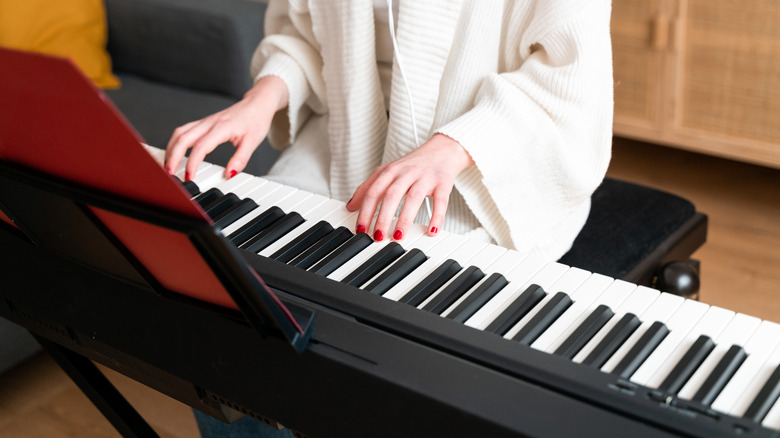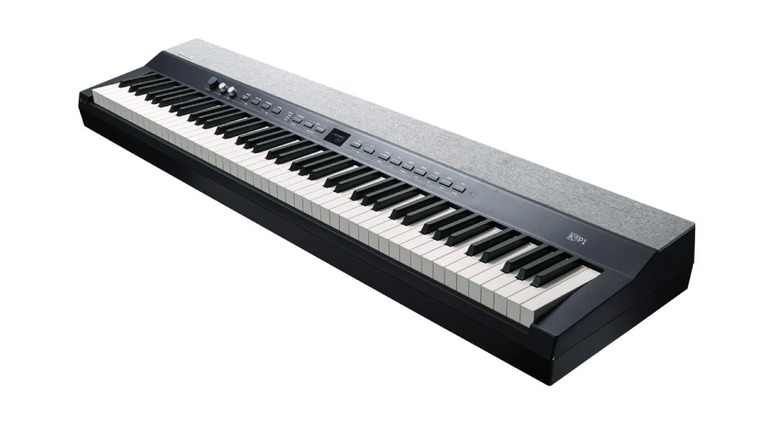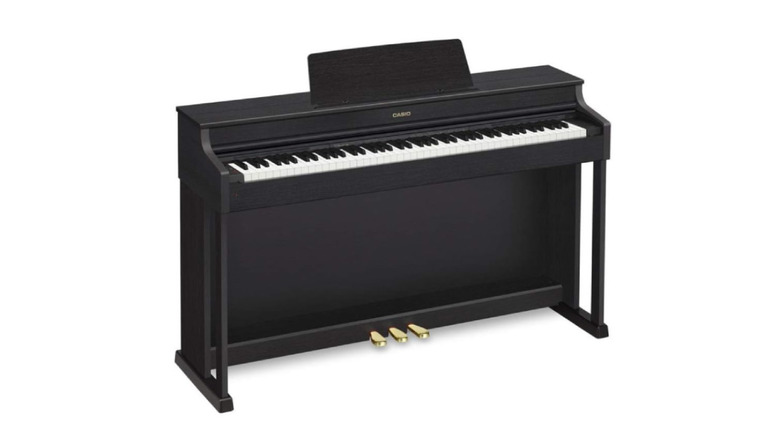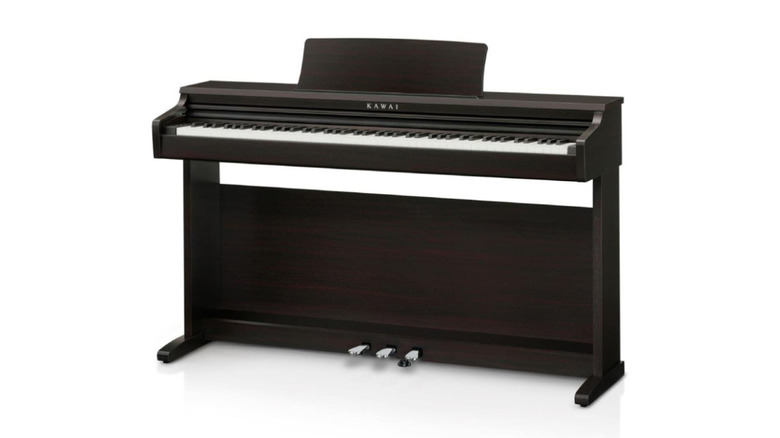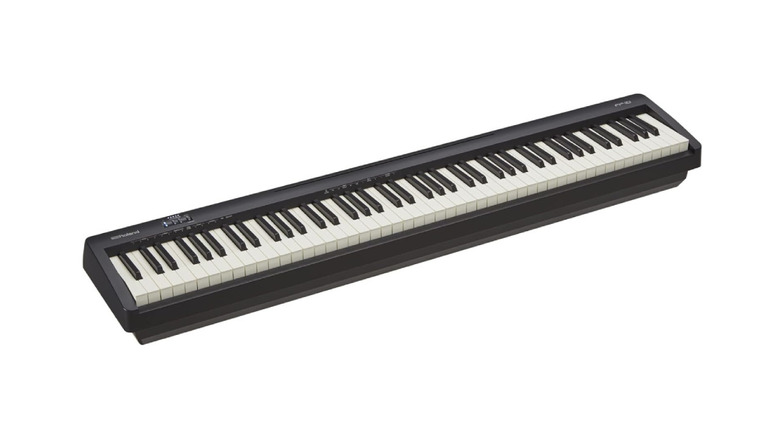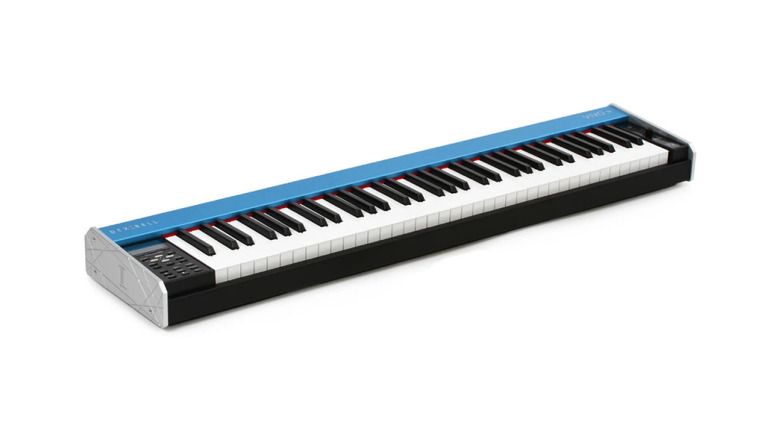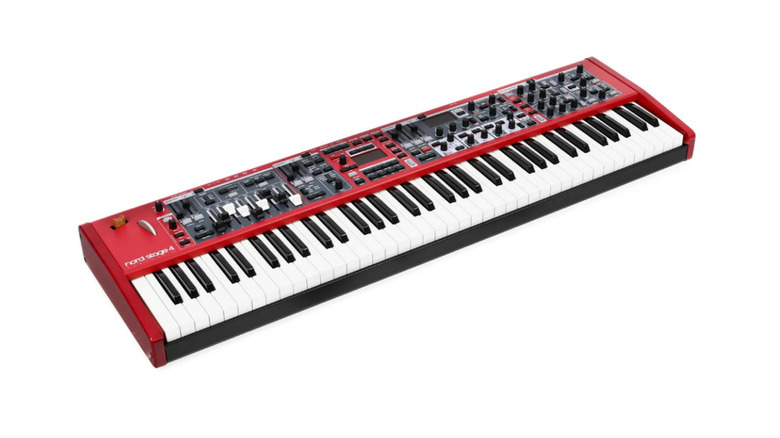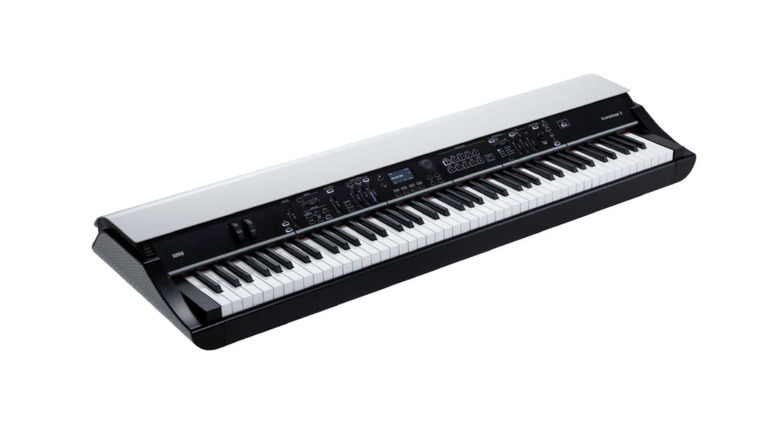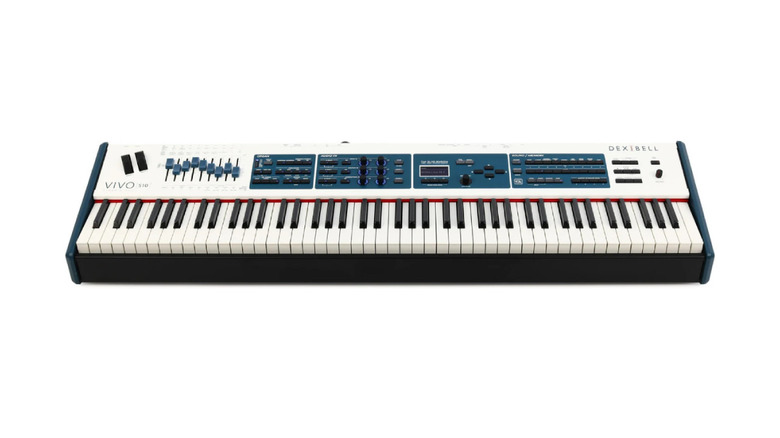Every Major Electric Piano & Keyboard Brand Ranked According To User Reviews
We may receive a commission on purchases made from links.
There's a big chance that you're in one of two camps when it comes to electric pianos versus keyboards. You might find that only those instruments, and only the best among them, can replicate the feeling of a real piano, or you don't see how a minuscule difference in the weight and pivot point of a piece of wood can bring the price of a mediocre rompler to the thousands of dollars. Alternatively, you might not know what an electric piano is at all. In a few words, an electric piano is a keyboard instrument meant to replicate the sound and feel of a real piano, and it's mostly used as a substitute for an acoustic instrument.
The expectation is that the keys will react differently to the touch than they do in a regular MIDI keyboard, an organ, or even a stage piano, and feel is often more important than sound. A sound library (a type of music production plugin) will ultimately beat any standalone electric piano when it comes to realism. Our list is focused on the biggest brands in the electric piano business, but even if you don't know anything about pianos, you're likely to recognize some of those names. The same brands behind the best electric pianos make plenty of other gear, including keyboards with piano-style action and stage keyboards aimed at pianists. That's why we decided to include these keyboard instruments in our ranking.
Kurzweil
Kurzweil doesn't have a wide range of music keyboards still in production, but it covers all the bases with what it makes. The Kurzweil KaP1 is a "portable" digital piano, extremely simple to use and conveniently priced, especially considering the included speakers. While reviewers note the beautiful design of the instrument, courtesy of prolific synthesizer designer Axel Hartmann, user reviews are surprisingly rare, all seemingly directed towards the SP1 Stage Piano. This keyboard was better received by users, though some note the limited number of presets as a negative. Still, at $900, this is far from Kurzweil's flagship model, so it's bound to have some limitations.
The flagship Kurzweil stage piano is the SP7 Grand. For just $2,000, it seems like a no-brainer, considering the 256 voices of polyphony, numerous effects, and 88 keys of hammer action. However, many of its users report a common crashing issue, which makes the machine far too unreliable for live use. The SP7 and SP7 Grand are a relatively recent addition to Kurzweil's lineup, so it's possible that this software issue will be resolved with a firmware upgrade. For the time being, however, it would be wise to look somewhere else first.
Studiologic
Studiologic's line of electric pianos and keyboards is called Numa, but no one would blame you for never having heard this name before. The Numa X Piano GT is the Studiologic top-of-the-line keyboard, and for the relatively low price of $2,000, it left its users happy. Even the ones who aren't enthusiastic about the numerous sounds and effects can't help but praise the wooden key bed of the Numa. The interface, on the other hand, is a little more divisive. While Studiologic tried to make it as straightforward as possible, with its color-coded knobs and screens, some users find it confusing, pointing fingers at the menu-diving and the multifunction buttons and knobs.
A much cheaper alternative to the Numa line is the Numa Compact SE and the Compact X SE. While they aren't nearly as popular as their bigger sibling, they still have their loyal fans. On top of being somewhat affordable, quite a few users like that, at just 14 lb, the Numa Compact keyboards are a lot lighter than most electric pianos, including more expensive models. Studiologic also makes some great keyboard MIDI controllers with integrated audio interfaces in the Studiologic SL line, and users rate them very positively. However, the lack of integrated sounds makes those clearly not electric pianos, making Studiologic's offering a little thin.
Casio
If you've ever had a cheap toy keyboard with even cheaper sounds, chances are it was a Casio. Indeed, many musicians still associate the name with cheesy 1990s romplers you can find for dirt cheap at garage sales. However, Casio has worked hard to rebuild its reputation. The Casio Celviano line, especially the AP-470, offers premium digital pianos that deliver, with some users comparing them to much pricier models. Outside of specific user reviews that are justifiably very excited about their new digital piano, the Casio Celviano has changed a lot of minds about the future of the brand.
From a maker of watches and compact cameras who also sells synths for some reason, Casio has become one of the major brands of electric pianos. While some users love the key action on higher-end models like the Casio PX-870, others regret their purchase because of common durability issues with the keyboard. This problem seems to be more prevalent with cheaper models, but that's hardly a soothing thought for those stuck with a broken key. Another word of advice on Casio: The company makes a lot of keyboards. Some, like the Casiotone CT-S1 or the CTS-500, are cheap alternatives to electric pianos aimed at students. Those are, by all accounts, very good at their job. But among all the arranger keyboards, dedicated synths, and even another line of electric pianos, Casio still makes cheesy toy keyboards for children. Please, stay away from those.
Kawai
Kawai is often associated with traditional acoustic pianos, but its electric pianos have been around for a while. The "introductory" KDP series, like the KDP120, includes some of the most popular models in the whole Kawai line, the cheapest of which are about $1,000. The MP models, including the stage piano MP11SE 88-Key, are an affordable alternative to the Nord Stage with fewer (but still great) sounds and wooden key action. Based on user reviews, it seems like this piano is going to change your life, especially if you want a great sound without needing to make adjustments.
The DG30 is another Kawai electric piano worth mentioning. While it looks like a hybrid machine, which Kawai makes in the form of the Novus, AnyTime, and Aures series, the DG30 is a regular electric piano (the CN39, according to some) in the body of a baby grand piano. Unless you really like the look, it's hard to justify the incredibly high price it commands.
The Kawai CN line is a step above the KDP, second only to the CA keyboards. Those expensive instruments might be worth their price, but they're significantly less popular than the rest of Kawai's gear. Much more popular is the cheaper (but still not cheap) dedicated digital piano ES110 and its modern iteration, the ES120. One user who owned both keyboards considers the keyboard of the ES120 to be a major improvement, though it's clear that the lower price helped the original maintain its popularity.
Roland
In the world of music gear, Roland is most known for its legendary drum machines and grooveboxes, many well-respected synthesizers, and some weird designs that never caught on. However, Roland is also a leader in the keyboard market, from some of the most popular beginner MIDI controllers to high-end stage pianos. Users claim the Roland FP-90X has one of the best actions ever mounted on a digital piano, and some of that applies to the cheapest entries in the FP line as well, like the FP-10. What's certain is that the FP-10 is one of the most popular entry-level electric pianos, as the number of positive user reviews on many music gear retailers makes clear.
Outside of the FP line, Roland offers two popular keyboard instruments (not including its many synthesizers). The cheapest is the Roland GO:Piano, a basic electric piano for beginners that nonetheless managed to impress users with its decent keyboard feel and low weight. On the other end of the spectrum sits the Roland V-Stage 88, a competitor to the Nord Stage. While it's more of a stage piano/organ/synth than a dedicated electric piano, users looking for a lot of sounds per buck who can tolerate a heavier-feeling keyboard might find this a great compromise.
Dexibell
Dexibell isn't the most popular brand of electric pianos, and it seems to be pretty much unheard of in the U.S. However, not being a household name hasn't stopped users and reviewers from recognizing its quality keyboards. Some of its most expensive boards, like the Vivo S stage pianos, are likened to the high-end of Nord's offerings but with a different feel in the key bed. Users of the high-end Vivo S10 88 Keys note that the instrument can be overwhelming at first, but after the learning curve is over, it hardly requires any menu diving.
The cheaper Vivo Stage S1 has its fans as well, as a no-nonsense stage MIDI keyboard with some good sounds loaded in. While it's a perfectly fine electric piano on its own, what makes the Vivo S1 unique is the ability to import your own sounds. While it's hard to say how many would buy an electric piano to use as a customizable rompler, it's clearly a selling point to some users. After all, removing the need to bring a PC and an audio interface along to every other gig is the main selling point of stage keyboards, and the Vivo S1 is cheaper than many stage keyboards with similar features.
Yamaha
Yamaha makes a wide range of products, including musical instruments and motorcycles, though the two divisions have operated independently since 1955. It's no surprise, then, that its stage keyboards and digital pianos are so beloved. The Yamaha P71 (and the P45, which is the same instrument under a different name) is one of the most popular entry-level electric pianos currently on the market. The selling points highlighted by users are the variety of sounds and the feel of the weighted keys. The price-to-quality ratio is another selling point of the P45/P71, while the sound of the integrated speakers isn't so universally beloved. This keyboard has no Bluetooth connectivity, but it does have a standard 3.5mm jack, which is actually better for playing an instrument.
While they don't quite qualify as electric pianos, as they don't come with weighted keys, the Yamaha Piaggero line makes for a decent second keyboard that is extremely portable. Some users even consider it one of the best keyboards for beginners. As for stage pianos, the Yamaha CP88 is the company's flagship model as far as piano-focused keyboards go. Users note the middling quality of some sounds, but that doesn't apply to the piano and e-piano sounds. The other two lines of Yamaha stage pianos are the YC, which is an "organ-focused stage keyboard" (but according to users, it's pretty good at pianos, too), and the CK, which is slightly cheaper and has more sounds but less control on the organs.
Nord
Nord is one of the most respected and most popular brands of electric pianos today. It's also one of the most expensive, but users seem to think the asking price is fair for what they bought. The popular Nord Stage series, now in its fourth generation, is more than just an electric piano, just as its price ($4,900 on a good day) is a lot more than that of a basic keyboard. Satisfied consumers note the variety and quality of sounds, as well as the lack of menu diving, as what justifies the price of this board.
However, while the Nord Stage avoids using complex menus, some users make it clear that this instrument is not as intuitive as they would have wanted — one going as far as saying you'd need to "enroll in a four-year institute in electronics in order to get the simplest of tasks accomplished." An alternative to the Stage, both simple to use and with a key action that more closely resembles a piano, is the Nord Piano 5. Users love the feel of the key bed and the sounds. Few seem to mind the lack of a dedicated organ engine. The Electro series doesn't quite excite in the same way. The sounds are mostly the same as those in the Stage, but the Electro's action isn't as beloved.
Korg
Korg is another darling of keyboard players with an ear for great electric pianos but a curiosity for exploring more sounds than those found in more traditional instruments. The brand has historically been more of a synth maker than a digital piano producer, but that didn't stop Korg from making heaps of keyboard instruments aimed at pianists. One of the most popular electric pianos by Korg (which the company calls "digital" pianos) is the B2 88-Keys, an affordable instrument for beginners. Many users really appreciate the feeling of the keys as well as the sound, while noticing that the integrated speakers aren't particularly great. Thankfully, digital pianos are one of those devices that still have a headphone jack.
Another popular digital piano, one quite a bit more expensive than the B2, is the Korg LP-380. While ratings are generally positive, users note a common issue with the integrated speakers and poorly calibrated sensitivity on the onboard sounds. Finally, among the most expensive electric pianos/stage pianos in Korg's lineup is the Korg Grandstage, which features classic acoustic pianos, EP emulation, multiple organ engines, and lots of PCM synths. The new and shiniest Korg Grandstage X doesn't have a lot of reviews yet, but users are extremely satisfied with their older models. Plus, at $3,000, the Korg is on the more affordable end of stage keyboards with weighted hammer action.
Methodology
We selected those brands based on their recognition and the number of positive user reviews. We also considered public discussions on music-maker forums as an indication of user sentiment toward the brands and their electric pianos.
